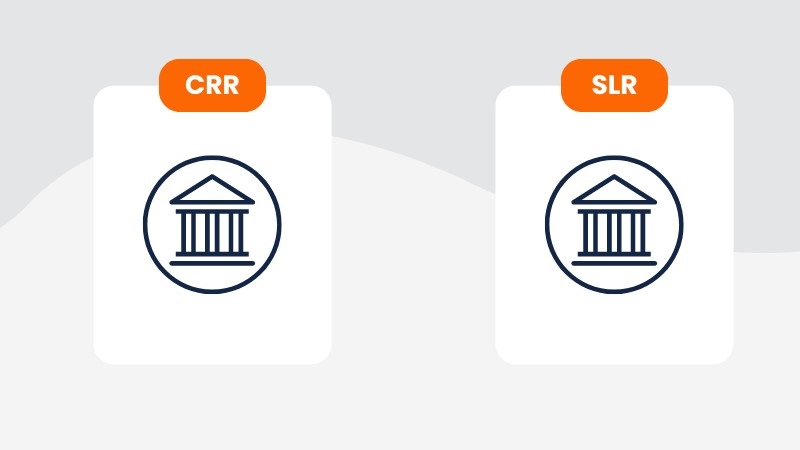The Cash Reserve Ratio (CRR) and the Statutory Liquidity Ratio (SLR) are like tools in a central bank’s toolbox, used to keep the banking system in check and help manage the country’s money matters. While both are aimed at keeping the financial world stable, they do so in different ways and for different reasons. In this article, we’ll delve into the distinctions between CRR and SLR, examine their pros and cons, and also shed light on the aspects they share.
CRR vs SLR: Differences Between CRR and SLR
The Reserve Bank of India (RBI) utilizes two key tools, Cash Reserve Ratio (CRR) and Statutory Liquidity Ratio (SLR), to influence the flow of money and manage inflation in the Indian economy.
The CRR mandates banks to hold a specific percentage of their total deposits as cash reserves with the RBI. On the other hand, the SLR requires banks to maintain a portion of their deposits in approved government securities. By adjusting these ratios, the RBI controls the amount of money banks can lend, influencing economic activity and overall financial stability.
The following are the major differences between CRR and SLR:
| Parameter | CRR (Cash Reserve Ratio) | SLR (Statutory Liquidity Ratio) |
| Explanation | Deposits that banks are required to keep in cash | Deposits held by banks in either gold, cash, or sanctioned securities |
| Calculation method | Proportion of net demand and time deposits | |
| Objective | Used by the RBI to control the liquidity in the economy | Used to guarantee that banks maintain adequate reserves to customer withdrawals |
| Application | Short-term money flow management | Management of long-term investments |
| Reserve Nature | Kept in the form of cash | Can be kept as cash, gold, or sanctioned securities |
| Sanction for Infringement | Compulsory for all banks | |
| Impact on Interest rates | Directly Proportional | Indirectly Proportional |
| Adaptability | It can be modified by the central bank | It can be modified by the central bank |
| Applicability | Applicable to demand deposits | Applicable to all types of deposits |
Also, read:
Key Differences Between CRR and SLR — Explained
- CRR is used as a percentage of money that a bank has to keep with RBI, while it is a proportion of liquid assets per a percentage of time and demand liabilities.
- CRR is kept as cash reserves, whereas SLR is held in cash, gold, and securities endorsed by the government.
- With SLR, the bank ensures the solvency of the bank, while CRR regulates the flow of money in the economy.
- The SLR is used to maintain the credit growth in the country whereas with CRR, RBI aims to liquidate the cash in the economy.
Similarities between CRR (Cash Reserve Ratio) and SLR (Statutory Liquidity Ratio)
CRR and SLR are both monetary tools that help the RBI to regularise economic growth. The following are the major similarities between the CRR and SLR:
- Both CRR and SLR are monetary policy tools implemented by RBI to maintain financial stability in the banking system.
- Both CRR and SLR are mandatory requirements for all scheduled commercial banks.
- CRR and SLR are expressed as a percentage of the net demand and time liabilities of banks.
- CRR and SLR influence the liquidity position of banks by requiring them to hold a certain portion of their deposits in specific forms.
- CRR and SLR act as safeguarding practices to maintain the stability and robustness of the banking sector.
- The central bank determines and can adjust the CRR and SLR rates to achieve desired economic objectives.
Advantages of SLR
- SLR promotes financial stability by ensuring banks maintain a certain level of liquid assets. This readily available buffer allows them to meet unexpected demands from depositors and helps them navigate financial challenges, reducing the risk of bank failures.
- By mandating banks to invest a portion of their deposits in government securities, the SLR helps fund government expenditures. This provides a stable source of financing for the government. It contributes to fiscal stability and facilitates investments in public infrastructure and social programs.
- The SLR helps manage overall liquidity in the financial system. Increasing the SLR can absorb excess liquidity, potentially curbing inflationary pressures, while decreasing it can inject liquidity into the system.
- The central bank can use differential SLR requirements for different categories of banks. For example, lower SLR for specific banks could encourage lending to certain sectors or regions, fostering financial inclusion and directing credit towards underserved areas.
- By requiring investment in government securities, which are considered low-risk assets, the SLR encourages banks to adopt a more conservative approach to risk management.
- The government securities held by banks through the SLR requirement typically offer a fixed rate of return. This provides banks with a stable source of income, contributing to their financial strength and profitability.
Advantages of CRR
- CRR mandates banks to hold a specific portion of deposits as reserves with the central bank. This readily available cash buffer allows banks to meet unexpected withdrawals and maintain liquidity in the financial system, fostering stability and public confidence.
- The central bank can control the amount of money in circulation by adjusting the Cash Reserve Ratio (CRR). When inflation is high, increasing the CRR reduces the amount of money available for lending, thereby dampening inflationary pressures.
- The CRR acts as a safeguard against potential bank failures. The readily available cash cushion provides a buffer in case of unexpected financial difficulties, protecting depositors’ funds and promoting financial stability.
- The CRR serves as a benchmark for banks’ lending rates. Banks cannot lend at rates lower than the CRR, fostering transparency and preventing predatory lending practices.
- The central bank can use CRR adjustments to regulate the flow of credit in the economy. By increasing the CRR, the central bank can slow down credit growth to prevent excessive borrowing and potential financial bubbles.
- Unlike open market operations, which can be time-consuming and complex, CRR adjustments offer a more direct and immediate way for the central bank to influence the money supply and credit availability.
- The central bank can use differential CRR requirements for different categories of banks to encourage lending to specific sectors like agriculture or small and medium enterprises (SMEs). This can promote financial inclusion and support economic development.
Disadvantages of SLR
The Statutory Liquidity Ratio (SLR), while promoting financial stability, comes with drawbacks. It can restrict credit flow by reducing the funds available for lending, potentially hindering economic growth.
The following are the major disadvantages of SLR:
- A higher SLR mandates banks to hold a larger portion of deposits as liquid assets, reducing the funds available for lending. This restricts credit flow, potentially hindering economic growth and business activity.
- To compensate for the reduced lending capacity, banks might raise interest rates on loans. This discourages borrowing and slows down economic activity.
- By limiting credit availability, SLR can hinder investments and entrepreneurial ventures, potentially slowing down economic growth, especially for sectors reliant on bank loans.
- SLR is a one-size-fits-all approach that doesn’t consider individual bank needs or specific economic situations. This can lead to inefficient resource allocation and reduced flexibility for banks to manage their liquidity.
- Banks may prioritise holding government securities mandated by SLR over potentially more profitable investments, leading to suboptimal use of resources within the banking system.
- Similar to CRR, smaller banks with limited resources might be disproportionately affected by SLR, as they have less flexibility to adjust their lending strategies and manage liquidity needs.
Disadvantages of CRR
CRR also has a range of disadvantages to offer, the same can be checked in the section below:
- When the CRR is raised, banks have less money available for lending, as they’re required to hold a larger portion of deposits as reserves. This can limit access to credit for businesses and individuals, potentially hindering economic growth.
- Banks earn profits primarily through lending activities. With less money to lend due to higher CRR, banks experience reduced profitability, which can affect their ability to invest in infrastructure and services.
- To compensate for the cost of holding CRR, banks might raise interest rates on loans. This discourages borrowing and further dampens economic activity
- CRR can lead to suboptimal allocation of resources. Instead of being directed towards potentially more productive investments, funds are held as mandated reserves, potentially hindering economic efficiency.
- Stringent CRR requirements can encourage the growth of unregulated shadow banking, posing potential risks to financial stability as borrowers and lenders operate outside the traditional banking system.
- Sudden and significant increases in CRR can lead to liquidity crunches in the banking system, impacting the smooth flow of funds and potentially causing financial instability.
Conclusion
In conclusion, CRR and SLR are important tools used by central banks to manage the monetary policy of a country. CRR regulates the flow of money in the economy, while SLR ensures that banks have sufficient funds to meet the demands of their customers. Understanding the differences between CRR and SLR is crucial for policymakers, bankers, and investors to make informed decisions and contribute to the growth and stability of the economy.
FAQs
What is the difference between CRR and LRR?
CRR holds deposits in cash with a central bank, while LRR stands for Legal Reserve Ratio.
What is the difference between the reserve ratio and the liquidity ratio?
Reserve ratio mandates holding deposits in specific forms, while liquidity ratio measures short-term financial obligation fulfilment.
What is the difference between CRR and SLR?
CRR holds cash reserves for liquidity, while SLR holds government securities for solvency and liquidity.
Explore PayMe’s Products:



